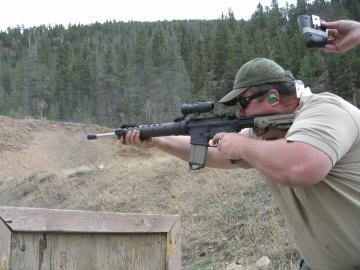

A shooter engages four targets with the 18-inch MSTN upper, shown here
with an Aimpoint M2 optic in a LaRue Tactical mount. The muzzle
device is the MSTN QC compensator.
Hornady sent me a couple cases of their 110-grain OTM loading to test. From the
box, the cartridges were clean and consistent. The primers are crimped, and the
case mouths are crimped into the the bullets' cannelure to ensure reliable
function in semi and full-auto weapons. The other striking feature is that the
bullets taper sharply with almost a spire point shape.
I tested the Hornady ammunition in three 6.8 SPC rifles: the Stag
Model 5, the Barrett M468, and a custom MSTN upper. To determine the
baseline performance, I shot it through an Oehler model 35P
chronograph. Between the two 16-inch and the one 18-inch upper, the
ammunition clocked at 2518 to 2564 feet per second (fps). The
standard deviation was less than 10 fps in each case, an indicator of
consistent ammunition.
To test the accuracy of the Hornady ammunition, I shot a series of
five-shot groups through each upper, from bags on a cement bench at
100 meters. The wind was five to 15 miles-per-hour, and unfortunately
the Barrett upper had to be tested in different conditions from the
other two uppers. The accuracy across the different uppers was
consistent, with the best group from each about 1.0 MOA. The average
group size was about a minute and a half across.
A compact bolt-action chambered in 6.8 SPC can make a good hunting or
short-range precision rifle for law enforcement. I had a friend of
mine shoot the Hornady ammunition through his Remington LTR. Its
20-inch barrel gained approximately 50 fps over the 18-inch upper.
Accuracy through the Nikon Tactical 4-16x50mm scope was slightly
better than the AR-15 uppers at 0.88 MOA center to center.


At the end of the day, the three rifles ran flawlessly on the Hornady
ammunition. Starting properly lubed, none of them required cleaning
throughout the exercise.
To determine the reliability of the Hornady 110-grain OTM, several
other shooters and I ran the remaining ammunition through the three
6.8 SPC uppers in some practical exercises. Getting the rifles hot
and dirty with repeated aimed fire drills puts more stress on the
weapons, magazines, and ammunition, than shooting from the bench or
slow target shooting. The Hornady ammunition performed flawlessly in
all three uppers. Examination of the fired brass revealed no
over-pressure indicators.
Though it took Hornady just over a year to bring their 6.8 SPC
ammunition to market, that development time was well-spent. The
110-grain OTM ammunition was designed around the end-users' requests
for a consistent load that would function with 100 percent reliability
in all rifles and provide improved terminal performance. When asked
if any new loadings are in the works, Wayne Holt said that Hornady is
willing to develop them if there is market demand.
|